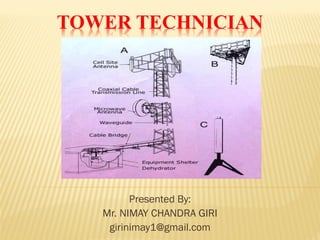
Cell tower, BTS & antennas
- 1. TOWER TECHNICIAN Presented By: Mr. NIMAY CHANDRA GIRI girinimay1@gmail.com
- 2. CONTENTE Objective Introduction GSM System & Architecture Network identities MS & BTS Architecture of BTS with configuration Antenna types & configurations Different pole types antennas Tilt
- 4. INTRODUCTION Acellsiteorcelltowerisacellulartelephonesitewhereantennaeandelectroniccommunicationsequipmentareplaced,usuallyonaradiomast,towerorotherhighplace,tocreateacell(oradjacentcells)inacellularnetwork. Frequencyreuse–samefrequencyin manycellsites Cellularexpansion–easytoaddnewcells Handover–movingbetweencells Roaming-betweennetworks
- 5. BRIEF HISTORY First telephone (photo phone) –Alexander Bell, 1880 The first car mounted radio telephone –1921 1946 –First commercial mobile radio-telephone service by Bell and AT&T in Saint Louis, USA. Half duplex(PTT) 1973 –First handheld cellular phone –Motorola. 1982„GroupeSpécialMobile”iscreatedwithinCEPT(ConférenceEuropéennedesPostesetTélécommunications) 1987MainRadiotransmissiontechniquesarechosen, basedonprototypeevaluation(1986) 1989GSMbecomesanETSItechnicalcommittee 1990ThePhaseIGSM900specificationarefrozen DCS1800adaptationstarts 1991Firstsystemsarerunning DCS1800specificationsarefrozen 1992AllmajorEuropeanGSM900operatorsbegincommercialoperations(2G) 20003Gsystemcomesintomarket. 20104Gsystemcomesintomarket.
- 6. GLOBAL SYSTEM FOR MOBILE COMMUNICATION GSMisastandarddevelopedbytheEuropeanTelecommunicationsStandardsInstitute(ETSI)todescribeprotocolsforsecond-generation(2G)digitalcellularnetworksusedbymobilephones.Asof2014ithasbecomethedefaultglobalstandardformobilecommunications-withover90%marketshare,operatinginover219countriesandterritories. 2Gnetworksdevelopedasareplacementforfirstgeneration(1G)analogcellularnetworks,andtheGSMstandardoriginallydescribedadigital,circuit- switchednetworkoptimizedforfullduplexvoicetelephony.Thisexpandedovertimetoincludedatacommunications,firstbycircuit-switchedtransport, thenbypacketdatatransportviaGPRS(GeneralPacketRadioServices) andEDGE(EnhancedDataratesforGSMEvolutionorEGPRS). Subsequently,the3GPPdevelopedthird-generation(3G)UMTSstandardsfollowedbyfourth-generation(4G)LTEAdvancedstandards,whichdonotformpartoftheETSIGSMstandard. GSMFunctions Transmission. Radio Resources management (RR). Mobility Management (MM). Communication Management (CM). Operation, Administration and Maintenance (OAM).
- 7. COMPARED TO FIXED NETWORK
- 9. NETWORK IDENTITIES IMEI(InternationalMobileEquipmentIdentity) MSISDN(MobileStationISDNNumber) IMSI(InternationalmobilesubscriberIdentity) TMSI(TemporaryMobilesubscriberIdentity) MSRN(MobileStationRoamingNumber)
- 10. MOBILE STATION (MS) AMobileStationconsistsoftwomainelements: Themobileequipmentorterminal. Therearedifferenttypesofterminalsdistinguishedprincipallybytheirpowerandapplication: The`fixed'terminalsaretheonesinstalledincars.Theirmaximumallowedoutputpoweris20W. TheGSMportableterminalscanalsobeinstalledinvehicles.Theirmaximumallowedoutputpoweris8W. Thehandhelsterminalshaveexperiencedthebiggestsuccessthankstotheweightandvolume, whicharecontinuouslydecreasing.Theseterminalscanemitupto2W.Theevolutionoftechnologiesallowstodecreasethemaximumallowedpowerto0.8W. TheSubscriberIdentityModule(SIM). TheSIMisasmartcardthatidentifiestheterminal.ByinsertingtheSIMcardintotheterminal, theusercanhaveaccesstoallthesubscribedservices.WithouttheSIMcard,theterminalisnotoperational. SIM has microprocessor and memory, IMSI, Authentication Key, Ki Security Algorithms:kc,A3,A8 PIN & PUK FunctionofMS: Voice and data transmission & receipt Frequency and time synchronization Monitoring of power and signal quality of the surrounding cells Provision of location updates even during inactive state
- 11. THE BASE STATION SUBSYSTEM (BSS) TheBSSconnectstheMobileStationandtheNSS.Itisinchargeofthetransmissionandreception.TheBSScanbedividedintotwoparts: TheBaseTransceiverStation(BTS)orBaseStation. TheBTScorrespondstothetransceiversandantennasusedineachcellofthenetwork.ABTSisusuallyplacedinthecenterofacell.Itstransmittingpowerdefinesthesizeofacell.EachBTShasbetweenoneandsixteentransceiversdependingonthedensityofusersinthecell. TheBaseStationController(BSC). TheBSCcontrolsagroupofBTSandmanagestheirradioresources(upto100BTSs).ABSCisprincipallyinchargeofhandovers,frequencyhopping,exchangefunctionsandcontroloftheradiofrequencypowerlevelsoftheBTSs.
- 12. BASE TRANSCEIVER STATION (BTS) OR BASE STATION (BS) Provides the radio links with the mobile station & BSC… RF resources such as frequency assignments, sector separation, transmit power control BTS connects to BSC through un-channelized T1 facilities or direct cables in co-located equipment (Abis) The protocols are proprietary and are based on High-level data link control (HDLC) Typically terminates the IS-2000 LAC/MAC protocols for common channels, although in some implementations such protocols are terminated at the BSC In case of dedicated channels, the BTS exchanges physical layer frames with the BSC over Abisinterface Typically equated to the physical site of the wireless network where antennas are located 3-cell BTS configuration is most common (max. up to 6 cell BTS)
- 13. OPERATION RANGE OF CELL TOWER Heightofantennaoversurroundingterrain(Line-of-sightpropagation). Thefrequencyofsignalinuse. Timinglimitationsinsometechnologies(e.g.,GSMislimitedto35km,with70kmbeingpossiblewithspecialequipment) Thetransmitter'sratedpower. Therequireduplink/downlinkdatarateofthesubscriber'sdevice. Thedirectionalcharacteristicsofthesiteantennaarray. Reflectionandabsorptionofradioenergybybuildingsorvegetation. Itmayalsobelimitedbylocalgeographicalorregulatoryfactorsandweatherconditions. GSM,haveafixedmaximumrangeof35kilometers(22mi) CDMAandIDENhavenobuilt-inlimit,butitispossibletogetbetween50to70km(30–45miles)
- 14. FUNCTIONS OF BTS Radio resources Signal Processing Signaling link management Synchronization Local maintenance handling Functional supervision and Testing Controls the radio link encryption error control signal strength
- 16. CONT… BTS has three levels; a)Antenna coupling level (ANC) b)Trans receiver level (TRX) c)Base station control function level (BSF) BTSisalsoreferredtoastheradiobasestation(RBS),nodeB(in3GNetworks)or,simply, thebasestation(BS).FordiscussionoftheLTEstandardtheabbreviationeNBforevolvednodeBiswidelyused.
- 17. GENERAL ARCHITECTURE OF BTS ABTSinhasthefollowingparts: Transceiver(TRX)Quitewidelyreferredtoasthedriverreceiver(DRX),DRXareeitherinformofsingle(sTRU),double(dTRU)oracompositedoubleradiounit(DRU).Itbasicallydoestransmissionandreceptionofsignals.Italsodoessendingandreceptionofsignalstoandfromhighernetworkentities(likethebasestationcontrollerinmobiletelephony). Poweramplifier(PA)AmplifiesthesignalfromDRXfortransmissionthroughantenna;maybeintegratedwithDRX. CombinerCombinesfeedsfromseveralDRXssothattheycouldbesentoutthroughasingleantenna.Allowsforareductioninthenumberofantennaused. DuplexerForseparatingsendingandreceivingsignalsto/fromantenna.Doessendingandreceivingsignalsthroughthesameantennaports(cablestoantenna). AntennaThisisthestructurethattheBTSliesunderneath;itcanbeinstalledasitisordisguisedinsomeway(Concealedcellsites). AlarmextensionsystemCollectsworkingstatusalarmsofvariousunitsintheBTSandextendsthemtooperationsandmaintenance(O&M)monitoringstations. ControlfunctionControlsandmanagesthevariousunitsofBTS,includinganysoftware.On-the-spotconfigurations,statuschanges,softwareupgrades,etc.aredonethroughthecontrolfunction. Basebandreceiverunit(BBxx)Frequencyhopping,signalDSP,.
- 18. ANTENNA COUPLING LEVEL (ANC) It is the stage between antenna & TRX. A single module called ANC performs function up to 4 RTXs. For higher capacity a COMBINER stage can be added.
- 19. TRANS RECEIVER LEVEL (TRX) Trans-receiverequipment. Usedforreception&transmissionofRFsignal. TheAbsoluteRadiofrequencychannelnumber(ARFCN)isallottedtooneTRX&eachARFCNisdividedin8timeslots,henceoneTRXcanprovideconnectionto8subscribersatatime. OneBTS=12TRX=12ARFCN=12*8=96Users Soatatimeonly96userscanmakecalls.
- 20. BASE STATION CONTROL FUNCTION LEVEL (BSF) This station is ensured by station Unit Module (SUMA): central unit of BTS. Only one SUMA for one BTS. Generally clocks for all other BTS module for synchronization purposes. Ex: Abis link… SUMA BSF
- 21. RF& BTSSTRUCTURE
- 23. CONT…
- 24. TYPES OF TOWER USED –Self Supporting –Monopoles –Guys
- 27. ANTENNAS TYPES USED PrimaryAntennatypesinWirelessconfigurationsare: OmniDirectional Broadcastsinalldirections Examplesarewhip,helicalanddipole Directional Broadcastinasingledirection ExamplesareYagi,andparabolic LeakyCoax Broadcastsalongpathofthecoaxialcable Coaxialcablewiththecloselyspacedslotsintheouterconductorallowingsignalstopenetratetothecore Leaky Coax
- 28. ELECTRICAL & MECHANICAL TILT Thetiltrepresentstheinclinationorangleoftheantennatoitsaxis. ElectricaltiltisusedforincreasingordecreasingofBeamradiation. (+)=>Tx&(-)=>Rx
- 29. MECHANICAL TILT Mechanical tilt is adjusted for maximum or minimum coverage area radiation.
- 30. MULTI-INPUT MULTI-OUTPUT (MIMO) ANTENNAS Mobile MIMO antenna Directional Base station MIMO antenna Dual band Wi-Fi MIMO antenna Single band Omni directional MIMO antenna 2.4-5 GHz
- 31. LONG TERM EVOLUTION (LTE) LongTermEvolution(LTE)istheworld'sleading4Gcellularnetworktechnology. LTE'shighdataratesandlowlatencyenableapplicationssuchasstreamingHDvideo,highdefinitionVoiceoverLTE(VoLTE), broadcasting,andpublicsafetyemergencyresponse. Bandwidthsrangingfrom1.4MHzto20MHz. ThismakesLTEanaturalupgradepathforcarrierswithbothGSM/UMTSandCDMA2000networks. Bandscurrentlyinuserangefrom450MHzto2700MHz,withbandsashighas3.5GHz. LTEMIMOantennasmustbecarefullydesignedinordertogetthefullbenefitofMIMOtechnology.